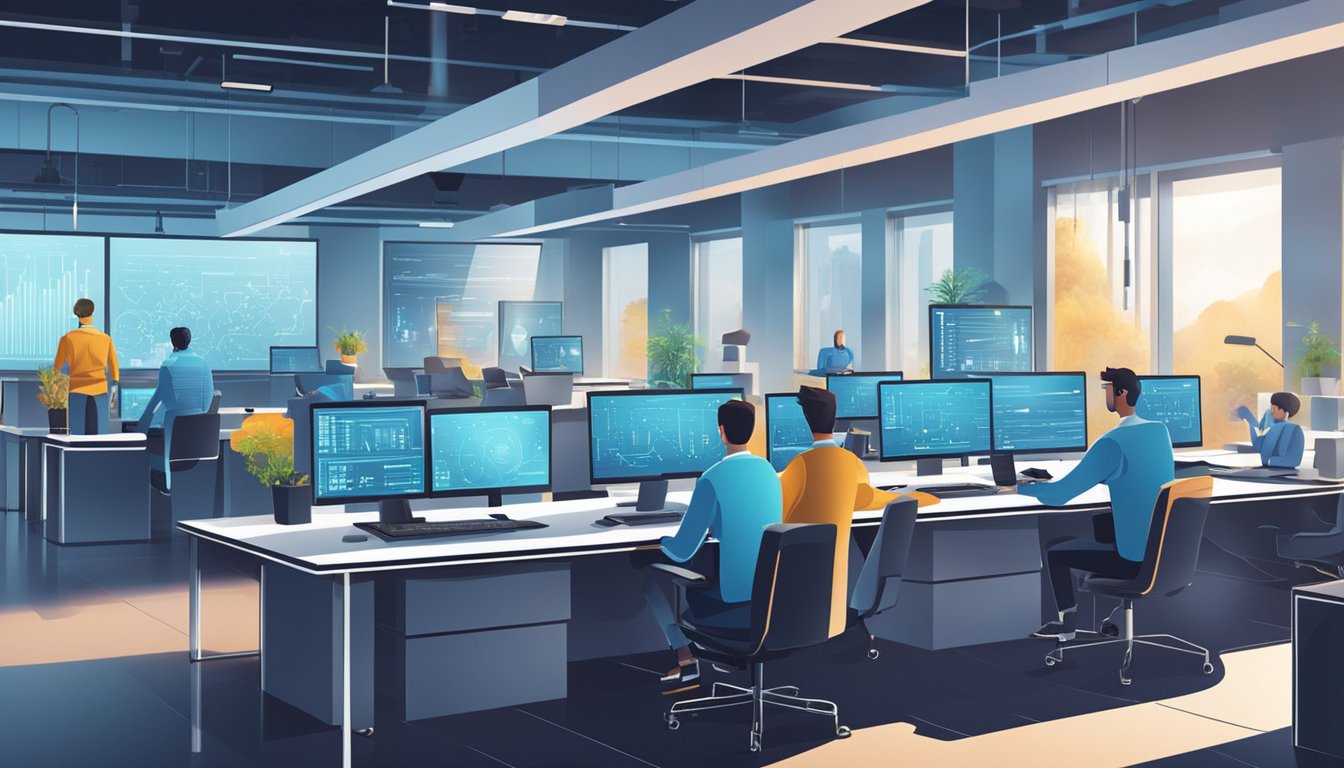The Cost of AI Automation: Examining Financial Implications and ROI
Ever wonder just how much you’d have to fork over to automate a slice of your business with AI? It’s a hot question, especially as artificial intelligence becomes less of a sci-fi dream and more of an everyday reality in the workplace. The cost of AI can swing from surprisingly affordable to “do I need to sell a kidney?” levels of pricey. In 2024, you might find AI solutions ranging from a free demo to custom-tailored systems creeping into the six-figure domain.

But why such a wild variation in prices? Well, it’s all about complexity and capability. Starting out with a basic MVP (Minimum Viable Product) for an AI solution can set you back a cool $50 thousand, give or take. Scale up the sophistication and the types of tasks you want your AI to tackle, and the costs will climb quicker than a squirrel chasing the last acorn of autumn.
Now, you might be asking yourself, “Is shelling out this kind of dough really worth it?” That’s the million-dollar question—sometimes quite literally. AI and automation promise to speed up, streamline or completely take over tasks that used to be in the human domain. But it’s a balance of initial investment against long-term savings and efficiency. Plus, there’s always the chance of hidden costs, such as potential liabilities associated with AI-induced oopsies. So, grab a seat and let’s unpack the real scoreboard of AI automation costs together—no fluff, just the wallet-hitting facts.
Understanding AI Automation

Before diving into the nitty-gritty, let’s clear the air: when we talk about AI automation, we’re discussing how machines mimic human actions and thoughts, not the latest sci-fi movie plot. It’s about making your life easier, be it through smart replies in your email or a virtual assistant booking your appointments. Now, let’s get to the meat of the matter!
AI and Automation Fundamentals
Wondering what makes AI tick? At its heart, AI enables machines to learn from experience, adapt to new inputs, and perform human-like tasks. A key component, machine learning, is like teaching computers to learn by munching on data, rather than hand-coding them with specific instructions. Think of it as feeding a computer a cookbook and expecting it to whip up a feast without any kitchen disasters.
AI isn’t just one-size-fits-all. Chatbots for instance, talk to you and tackle customer service like champs, thanks to natural language processing (NLP), a branch of AI that’s all about understanding and generating human language. Remember that types of AI vary from the simple, rule-based systems we see in automated calendar scheduling to the more complex artificial intelligence systems predicting stock market trends.
Types of AI Systems
Now, let’s unbox the different types of AI systems:
- Narrow AI: Good at one task, whether it’s playing chess or suggesting the shortest driving route. It’s like a one-trick pony, but what a trick it is!
- General AI: This is the holy grail—machines with the ability to understand and learn any intellectual task a human can. We’re not quite there yet, but who doesn’t love a goal?
- Strong AI: A vision of machines with consciousness (cue dramatic music). It’s more of a philosophical conversation right now than an engineering one.
Got it? Great! Remember, AI is here to serve you, and understanding it is the first step towards harnessing its potential in the world of automation. Keep your eyes peeled for how AI continues to evolve and shape different sectors, and maybe, just maybe, we’ll soon have robots bringing us our morning coffee.
Economic Implications

As you explore the world of AI, have you considered its financial ripple effects? Buckle up, because we’re diving into how AI shakes up the economic terrain.
AI’s Impact on Economic Growth
Did you know that AI could be a formidable tailwind to the global economy? It’s like a tech-fueled jetpack strapped to the back of economic progress. According to a McKinsey report, AI has the muscle to pump up global economic activity to the tune of $13 trillion by 2030. That’s an increase in cumulative GDP of a whopping 16 percent. Imagine that—AI could dish out an extra 1.2 percent GDP growth each year. That’s not just a tiny boost; it’s a full-blown economic transformation.
Cost Factors in AI Implementation
Now, let’s talk about the dollars and cents of bringing AI into the mix. It all boils down to calculating your return on investment, or ROI. You wouldn’t buy a car without peeking under the hood, right? Similarly, investing in AI calls for scrutinizing cost factors. Think of it as a balancing act between the initial investment and the expected gains.
For starters, not all tasks are economically feasible to automate. A peek into a MIT CSAIL study reveals only about 23 percent of wages for vision-related tasks are currently viable to replace with AI. This means you’re looking at only one-fourth of vision-centric jobs where AI swoops in to save the day cost-effectively. Keep this in mind, because when it comes to AI, it’s not just about what it can do, but what it makes economic sense to apply it to.
Automation in Business

Have you ever thought about how automation is redefining the way we do business? It’s transforming everything from how companies operate to how they engage with customers. Let’s dive in!
Business Process Transformation
AI automation isn’t just a buzzword—it’s the powerhouse driving business processes into the future. Imagine the possibility of reducing manual effort, slashing errors to nearly zero, and supercharging productivity. That’s what we’re talking about here. For instance, with sophisticated AI, some companies are seeing a potential annual value of up to $5.8 trillion from advanced deep learning techniques. Mind-blowing, right?
- Streamlined Operations: Complex tasks are simplified, leading to smoother entrepreneurial operations.
- Enhanced Efficiency: With less time spent on repetitive tasks, employees focus on strategic work.
Think about it: Why spend hours on inventory management when a smart system can do it for you in a jiffy?
Enhancing Customer Experience
Now, let’s chat about your customers—AI automation is their new best friend. We’re looking at personalized interactions at scale, tailor-made suggestions, and even round-the-clock support. One study revealed that over half of business owners utilize AI to beef up their cybersecurity and fraud management, which is crucial for safeguarding customer trust.
- 24/7 Support: Bots and virtual assistants offer help any time, any day.
- Customization at its Best: AI algorithms analyze data to provide customers with what they need before they even ask for it.
Don’t you just love it when a business remembers your preferences? Well, that’s AI making your experience smoother and more delightful.
With these innovations, businesses are pioneering a new era where every interaction and operation is more efficient and customer-centric. Get ready to embrace this change and see your business soar!
AI Technologies and Investments

Have you ever considered how much it actually costs to bring AI into your business? Whether you’re looking into custom AI solutions or flirting with the idea of third-party AI software, let’s dig into the investment and cost specifics.
Investing in AI Projects
When you’re ready to take the AI plunge, one of the first things you’ll encounter is the range of investment options. Committing to AI projects can be exciting, but it’s important to understand where your money’s going. Consider this: many AI consultants are currently charging between $200 to $350 per hour. Let’s say you’re eyeing those savvy chatbots, which according to WebFX, could set you back up to $40,000 per year for a service. But if your operation is more in the entrepreneurial spirit, some free applications might just do the trick. Deciding on whether to build from scratch or to capitalize on existing technologies will significantly impact your AI adoption journey.
Cost Considerations for AI Development
As you might expect, the development cost isn’t a one-size-fits-all scenario. Crafting custom AI solutions tailored to your business specifics tends to require a heftier initial investment. However, the tailor-fitted nature of these solutions often translates into long-term cost savings and efficiency gains. On the flip side, tapping into third-party AI software might seem like a bargain at the outset. Just remember, subscription fees can add up, and you may face additional costs for updates or customization down the line. Keep these financial tidbits in mind when deciding the best route for integrating AI into your business strategy.
Challenges and Risks of AI Automation
When you think of AI automation, it’s easy to picture sleek robots and smart algorithms making life easier, right? But it’s not all smooth sailing. Let’s take a peel back the layers and see what’s cooking in the world of AI, particularly the bits that might give us a bit of heartburn – I’m talking about the complex challenges and the risks that could trip us up.
Managing Complexity and Accuracy
Have you ever tried juggling? Well, managing the complexity of AI systems can feel a bit like juggling with six balls in the air – it’s complex, and accuracy is everything. AI systems can be intricate networks with multiple layers, and ensuring that they consistently deliver accurate results can be a tall order.
- Complexity: AI systems process vast amounts of data through complex algorithms. Keeping all parts working in harmony without any hiccups is, to put it mildly, quite a feat.
- Accuracy: The goal is to reduce errors, but no system is perfect, right? Ensuring high accuracy is crucial because mistakes can be costly. Even a tiny mistake can cause a ripple effect of unintended consequences.
McKinsey emphasizes the need for a dedicated center of excellence for managing these intelligent-automation risks.
Navigating Data Privacy and Liability
Now, let’s talk about walking the tightrope of data privacy and liability. In this digital age, data is like currency, and protecting it is non-negotiable. However, AI systems can sometimes be a bit too nosy, right? That’s where data privacy laws come into play, and you don’t want to be on the wrong side of those.
- Data Privacy: With AI, there’s always the worry that personal data might end up where it shouldn’t. You need to be mindful of what data your AI handles and how it’s protected.
- Liability: If something goes wrong, who’s to blame? The AI, its creators, or the users? Determining liability in AI-related mishaps can be as tricky as finding a needle in a haystack.
And let’s not forget the risk of fraud – with AI, the stakes are high, and so is the creativity of those looking to exploit its vulnerabilities.
Navigating these waters means being vigilant about the data your AI has access to and knowing the ins and outs of the relevant laws – it’s a bit like having a map when you’re exploring unknown territory. Deloitte points out the importance of evolving governance and operational controls in this digital era.
AI automation might be the future darling, but it’s not without its share of thorny issues. Staying informed and prepared is your best bet in harnessing its power without getting caught in the thicket.
Sector-Specific AI Applications
AI is shaking things up, bringing in cool new ways to tackle everyday tasks! Whether it’s figuring out what customers want before they do or keeping track of every penny, AI’s got it covered. Let’s see how this tech magic is playing out across different sectors, shall we?
AI in Retail and Supply Chain
Ever wondered how your favorite store knows just what you’re looking for? AI in retail is all about giving you that “they read my mind!” feeling. With AI applications in marketing, stores can predict trends and stock up on what shoppers will scramble for next. It’s not just guesswork; it’s analytics turning heaps of data into your next shopping spree. Plus, behind the scenes, AI in the supply chain is the unsung hero ensuring your goodies move from A to B without a hitch. Robots in warehouses? You bet! Robotics are changing the game, picking and packing at superhuman speeds. Pretty neat, right?
AI in Financial Services
Banking’s getting a facelift with AI, and it’s not just about fancy ATMs. AI in financial services is like having a super-smart buddy keeping an eye on your cash, suggesting ways to save and grow it. We’re talking sophisticated software that can spot fishy transactions or help you invest smartly. And customer service? It’s getting a boost too. Those chatbots you talk to? They’re AI-driven, learning from each conversation to help you better next time. It’s like having a banker in your pocket! Plus, with analytics, financial bigwigs can make sense of complex market patterns, making sure your money’s doing what it should be.
Isn’t it amazing how AI is getting things done across the board? From shops to banks, software is not just working hard; it’s working smart. And that’s pretty cool if you ask me!
AI Automation Strategy and Execution
Before diving into the exciting world of AI Automation, it’s crucial for you to understand that a well-thought-out strategy and meticulous execution are the pillars of success in this realm. It’s not just about having the technology; it’s about knowing how to use it to streamline your processes effectively.
Planning and Pilot Projects
Think of planning like plotting your treasure map, with X marking the spot for success. First, it’s imperative to define clear objectives. Ask yourself, what processes are ripe for automating? It’s about picking the low-hanging fruit to get some quick wins on the board. For example, many businesses start with automating repetitive tasks such as data collection or data analytics.
Once you have your plan, it’s time for a pilot. This is where you test the waters with a small-scale project. It’s your sandbox to play in – no pressure! This trial run helps you understand the potential of your technology stack and refine your workflow. Remember the analysis conducted on AI use cases, which shows how deep learning techniques can significantly contribute to value creation? Well, your pilot is your first step towards tapping into that potential.
Scaling AI Efforts Across the Enterprise
Congratulations on nailing your pilot! Now, let’s talk scaling. It’s like taking your pilot and giving it an unlimited gym membership – it’s time to bulk up. The goal is to integrate AI automation enterprise-wide. But beware, this isn’t just about going bigger, it’s about going smarter.
- Examine the data from your pilot and identify what worked and what didn’t.
- Prepare a scalable technology infrastructure that can handle an increased load.
- Define key performance indicators (KPIs) to measure success at every stage.
Scaling up means automating more complex processes and ensuring your automation strategy plays nice with all areas of your business. And remember, the end game isn’t just about cutting costs, it’s also about enhancing your company’s agility and efficiency. Let’s not forget the imperatives for automation success — it’s about shifting focus from sheer automation to strategic innovation. Ready to turn your AI automation strategy into action? Let’s get moving!
The Future of AI Automation
You’ve probably heard about the explosive growth in AI technologies and how they’re shaping our future. In this sneak peek into tomorrow, we’ll explore just how AI will continue to streamline our lives and confront the big societal challenges, such as climate change. Now, let’s cut to the chase and see what’s cooking in the AI kitchen!
Predicting Trends in AI Advancement
What’s the growth forecast in the AI world, you ask? Well, let’s look at some numbers that tell the tale. Advanced deep learning is expected to create a colossal $3.5 trillion to $5.8 trillion in annual value. That’s a whopping 40 percent of the value created by all analytics techniques! AI is not just taking steps; it’s leaping forward, and we’re here for the ride.
- Growth: Rapid, almost breakneck.
- AI Technologies: Deep learning is the superstar here.
- Media & Disruption: These sectors are poised for a shake-up; expect to see businesses harnessing AI in novel ways.
Fun Fact: Did you know AI is becoming a C-suite favorite? That’s right, the top brass is getting serious about AI’s value—with automation’s help.
AI’s Role in Tackling Societal Challenges
Now, onto something even more profound, AI’s role in our society. Imagining AI as a superhero isn’t far-fetched. Have a look at how AI is set to take on societal issues:
- Climate Change: Cutting-edge AI technology is gearing up to help us understand and fight climate change better.
- Societal Challenges: From healthcare to education, AI’s got potential solutions up its sleeve.
Remember reading about that global network dedicated to co-designing agile frameworks for AI governance? They’re tackling everything from data policy to precision medicine, and they mean business when it comes to shaping the future.
Exciting times ahead, right? Whether it’s the meteoric rise in AI’s capabilities or its mission to make the world a better place, you’re in the front row to witness history in the making. Stay tuned; this is one show you won’t want to miss!
Optimizing AI For Business
When you integrate AI into your business, you’re not just investing in technology, you’re revolutionizing your operations—maximizing efficiency, optimizing processes, and turning a considerable ROI. Let’s discover how to make AI work harder for you.
Maximizing ROI With AI
Are you wondering how AI can become your financial ace? It’s all about smart investments. When you tailor machine learning algorithms to suit your business needs, you strike gold by speeding up your processes, increasing precision, and reducing costly errors. Just imagine cutting down operational costs and watching your profit margins soar!
- Cost savings: AI can considerably reduce expenses by automating routine tasks.
- Efficiency: Time is money, and AI helps you save tons of it!
- Analysis systems: Big data can be overwhelming, but AI breaks it down, giving you actionable insights.
Optimizing Processes and Workflows
Now, let’s talk streamlining. Integrating AI in business is like hiring a team that works round the clock without taking a break. By implementing process automation, you eliminate bottlenecks and get things moving at an unprecedented pace, which means delivering your services or products faster and more reliably to your customers.
- Action: Assign repetitive tasks to AI and free up your human workforce for more complex projects.
- Optimization: Use AI to routinely audit and improve business processes.
- ROI: Let AI handle the grunt work while you focus on growing your business.
Frequently Asked Questions
When dipping our toes into the world of AI automation, costs can be a bit of a head-scratcher, can’t they? But don’t worry, we’re here to break down your burning questions into digestible bits, providing clarity on those dollar signs associated with AI integration.
What factors contribute to the cost of implementing artificial intelligence in industries like healthcare?
In healthcare, the cost of AI implementation is driven by complex data needs, the integration with existing technology systems, and strict compliance regulations. These can stack up, making the integration a significant investment.
Can you break down the typical expenses involved in creating an AI system?
Creating an AI system typically involves expenses for hardware, software development, data collection and processing, and hiring personnel with expertise in AI. Sometimes, you’re also looking at ongoing costs for maintenance and updates.
What pricing models are usually considered when investing in AI technology?
Investing in AI might remind you of picking a phone plan, where you consider various pricing models. You can have subscription-based models, pay-per-use, or even custom pricing based on the complexity of the solution required by your business.
Why might businesses experience a high price tag when integrating AI into their operations?
AI integration can carry a high price tag due to the need for high-end computing resources, the cost of data acquisition, specialized talent, and potential operational disruptions during implementation.
How do the development costs for advanced AI technologies, such as Generative AI, differ from simpler AI applications?
Advanced AI technologies such as Generative AI often require more investment in research and development, are typically data-hungry, and need higher computational power. This contrasts with simpler applications that might rely on pre-existing frameworks and lesser computing needs.
What are the financial implications of deploying AI robots within various sectors?
Deploying AI robots across sectors can mean a significant upfront investment in hardware and software. Ongoing expenses include maintenance, updates, and energy costs, not to mention training your crew to work alongside their new robotic teammates.








